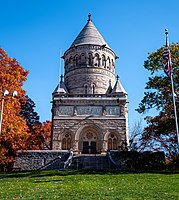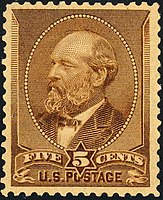
James A. Garfield
James Abram Garfield (November 19, 1831 – September 19, 1881) was the 20th president of the United States, serving from March 1881 until his death the following September after being shot by an assassin in July. A preacher, lawyer, and Civil War general, Garfield served nine terms in the United States House of Representatives and is the only sitting member of the House to be elected president. Before his candidacy for the presidency, he had been elected to the U.S. Senate by the Ohio General Assembly—a position he declined when he became president-elect.
"James Garfield" redirects here. For other uses, see James Garfield (disambiguation).
James A. Garfield
Chester A. Arthur
Lucius V. Bierce
September 19, 1881 (aged 49)
Elberon, New Jersey, U.S.
Massive infection including sepsis and pneumonia, after being shot
- Politician
- lawyer
- amateur mathematician
1861–1863
- 42nd Ohio Volunteer Infantry
- 20th Brigade, 6th Division, Army of the Ohio
Garfield was born into poverty in a log cabin and grew up in northeastern Ohio. After graduating from Williams College, he studied law and became an attorney. He was a preacher in the Stone–Campbell Movement and president of the Western Reserve Eclectic Institute, affiliated with the Disciples.[1][a] Garfield was elected as a Republican member of the Ohio State Senate in 1859, serving until 1861. He opposed Confederate secession, was a major general in the Union Army during the American Civil War, and fought in the battles of Middle Creek, Shiloh, and Chickamauga. Garfield was elected to Congress in 1862 to represent Ohio's 19th district. Throughout his congressional service, he firmly supported the gold standard and gained a reputation as a skilled orator. He initially agreed with Radical Republican views on Reconstruction but later favored a Moderate Republican–aligned approach to civil rights enforcement for freedmen. Garfield's aptitude for mathematics extended to his own proof of the Pythagorean theorem, which he published in 1876.
At the 1880 Republican National Convention, delegates chose Garfield, who had not sought the White House, as a compromise presidential nominee on the 36th ballot. In the 1880 presidential election, he conducted a low-key front porch campaign and narrowly defeated the Democratic nominee, Winfield Scott Hancock. Garfield's accomplishments as president included his assertion of presidential authority against senatorial courtesy in executive appointments, a purge of corruption in the Post Office, and his appointment of a Supreme Court justice. He advocated for agricultural technology, an educated electorate, and civil rights for African Americans. He also proposed substantial civil service reforms, which were passed by Congress in 1883 as the Pendleton Civil Service Reform Act and signed into law by his successor, Chester A. Arthur.
Garfield was a member of the intraparty "Half-Breed" faction who used the powers of the presidency to defy the powerful "Stalwart" Senator Roscoe Conkling from New York. He did this by appointing Blaine faction leader William H. Robertson to the lucrative post of Collector of the Port of New York. The ensuing political battle resulted in Robertson's confirmation and the resignations of Conkling and Thomas C. Platt from the Senate.
On July 2, 1881, Charles J. Guiteau, a disappointed and delusional office seeker, shot Garfield at the Baltimore and Potomac Railroad Station in Washington. The wound was not immediately fatal, but an infection caused by his doctors' unsanitary methods in treating the wound killed Garfield on September 19. Due to his brief tenure in office, historians tend to rank Garfield as a below-average president, though he has earned praise for anti-corruption and pro–civil rights stances.[3]
Garfield's funeral train left Long Branch on the same special track that had brought him there, traveling over tracks blanketed with flowers and past houses adorned with flags. His body was transported to the Capitol and then continued on to Cleveland for burial.[239] Shocked by his death, Marine Band leader John Philip Sousa composed the march "In Memoriam", which was played when Garfield's body was received in Washington, D.C.[240] More than 70,000 citizens, some waiting over three hours, passed by Garfield's coffin as his body lay in state from September 21 to 23, 1881,[241] at the United States Capitol rotunda; on September 25, in Cleveland, Garfield's casket was paraded down Euclid Avenue from Wilson Avenue to Public Square, with those in attendance including former presidents Grant and Hayes, and Generals William Sherman, Sheridan and Hancock.[242] More than 150,000—a number equal to the city's population—likewise paid their respects, and Sousa's march was again played.[239][243] Garfield's body was temporarily interred in the Schofield family vault in Cleveland's Lake View Cemetery until his permanent memorial was built.[239][244]
Memorials to Garfield were erected across the country. On April 10, 1882, seven months after Garfield's death, the U.S. Post Office Department issued a postage stamp in his honor.[245] In 1884, sculptor Frank Happersberger completed a monument on the grounds of the San Francisco Conservatory of Flowers.[246] In 1887, the James A. Garfield Monument was dedicated in Washington.[247] Another monument, in Philadelphia's Fairmount Park, was erected in 1896.[248] In Victoria, Australia, Cannibal Creek was renamed Garfield in his honor.[249]
On May 19, 1890, Garfield's body was permanently interred, with great solemnity and fanfare, in a mausoleum in Lake View Cemetery. Attending the dedication ceremonies were former President Hayes, President Benjamin Harrison, and future president William McKinley.[251] Garfield's Treasury Secretary, William Windom, also attended.[251] Harrison said Garfield was always a "student and instructor" and that his life works and death would "continue to be instructive and inspiring incidents in American history".[252] Three panels on the monument display Garfield as a teacher, Union major general, and orator; another shows him taking the presidential oath, and a fifth shows his body lying in state at the Capitol rotunda in Washington, D.C.[253]
Garfield's murder by a deranged office-seeker awakened public awareness of the need for civil service reform legislation. Senator George H. Pendleton, a Democrat from Ohio, launched a reform effort that resulted in the Pendleton Act in January 1883.[254] This act reversed the "spoils system" where office seekers paid up or gave political service to obtain or keep federally appointed positions.[254] Under the act, appointments were awarded on merit and competitive examination.[255] To ensure the reform was implemented, Congress and Arthur established and funded the Civil Service Commission. The Pendleton Act, however, covered only 10% of federal government workers.[255] For Arthur, previously known for having been a "veteran spoilsman", civil service reform became his most noteworthy achievement.[256]
A marble statue of Garfield by Charles Niehaus was added to the National Statuary Hall Collection in the Capitol in Washington D.C., a gift from the State of Ohio in 1886.[257]
Garfield is honored with a life-size bronze sculpture inside the Cuyahoga County Soldiers' and Sailors' Monument in Cleveland, Ohio.[258]
On March 2, 2019, the National Park Service erected exhibit panels in Washington to mark the site of his assassination.[259]



